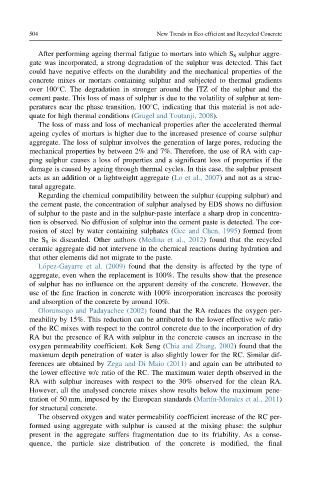Page 556 - New Trends in Eco efficient and Recycled Concrete
P. 556
504 New Trends in Eco-efficient and Recycled Concrete
After performing ageing thermal fatigue to mortars into which S 8 sulphur aggre-
gate was incorporated, a strong degradation of the sulphur was detected. This fact
could have negative effects on the durability and the mechanical properties of the
concrete mixes or mortars containing sulphur and subjected to thermal gradients
over 100 C. The degradation in stronger around the ITZ of the sulphur and the
cement paste. This loss of mass of sulphur is due to the volatility of sulphur at tem-
peratures near the phase transition, 100 C, indicating that this material is not ade-
quate for high thermal conditions (Grugel and Toutanji, 2008).
The loss of mass and loss of mechanical properties after the accelerated thermal
ageing cycles of mortars is higher due to the increased presence of coarse sulphur
aggregate. The loss of sulphur involves the generation of large pores, reducing the
mechanical properties by between 2% and 7%. Therefore, the use of RA with cap-
ping sulphur causes a loss of properties and a significant loss of properties if the
damage is caused by ageing through thermal cycles. In this case, the sulphur present
acts as an addition or a lightweight aggregate (Lo et al., 2007) and not as a struc-
tural aggregate.
Regarding the chemical compatibility between the sulphur (capping sulphur) and
the cement paste, the concentration of sulphur analysed by EDS shows no diffusion
of sulphur to the paste and in the sulphur-paste interface a sharp drop in concentra-
tion is observed. No diffusion of sulphur into the cement paste is detected. The cor-
rosion of steel by water containing sulphates (Gee and Chen, 1995) formed from
the S 8 is discarded. Other authors (Medina et al., 2012) found that the recycled
ceramic aggregate did not intervene in the chemical reactions during hydration and
that other elements did not migrate to the paste.
Lo ´pez-Gayarre et al. (2009) found that the density is affected by the type of
aggregate, even when the replacement is 100%. The results show that the presence
of sulphur has no influence on the apparent density of the concrete. However, the
use of the fine fraction in concrete with 100% incorporation increases the porosity
and absorption of the concrete by around 10%.
Olorunsogo and Padayachee (2002) found that the RA reduces the oxygen per-
meability by 15%. This reduction can be attributed to the lower effective w/c ratio
of the RC mixes with respect to the control concrete due to the incorporation of dry
RA but the presence of RA with sulphur in the concrete causes an increase in the
oxygen permeability coefficient. Kok Seng (Chia and Zhang, 2002) found that the
maximum depth penetration of water is also slightly lower for the RC. Similar dif-
ferences are obtained by Zega and Di Maio (2011) and again can be attributed to
the lower effective w/c ratio of the RC. The maximum water depth observed in the
RA with sulphur increases with respect to the 30% observed for the clean RA.
However, all the analysed concrete mixes show results below the maximum pene-
tration of 50 mm, imposed by the European standards (Martı ´n-Morales et al., 2011)
for structural concrete.
The observed oxygen and water permeability coefficient increase of the RC per-
formed using aggregate with sulphur is caused at the mixing phase: the sulphur
present in the aggregate suffers fragmentation due to its friability. As a conse-
quence, the particle size distribution of the concrete is modified, the final

